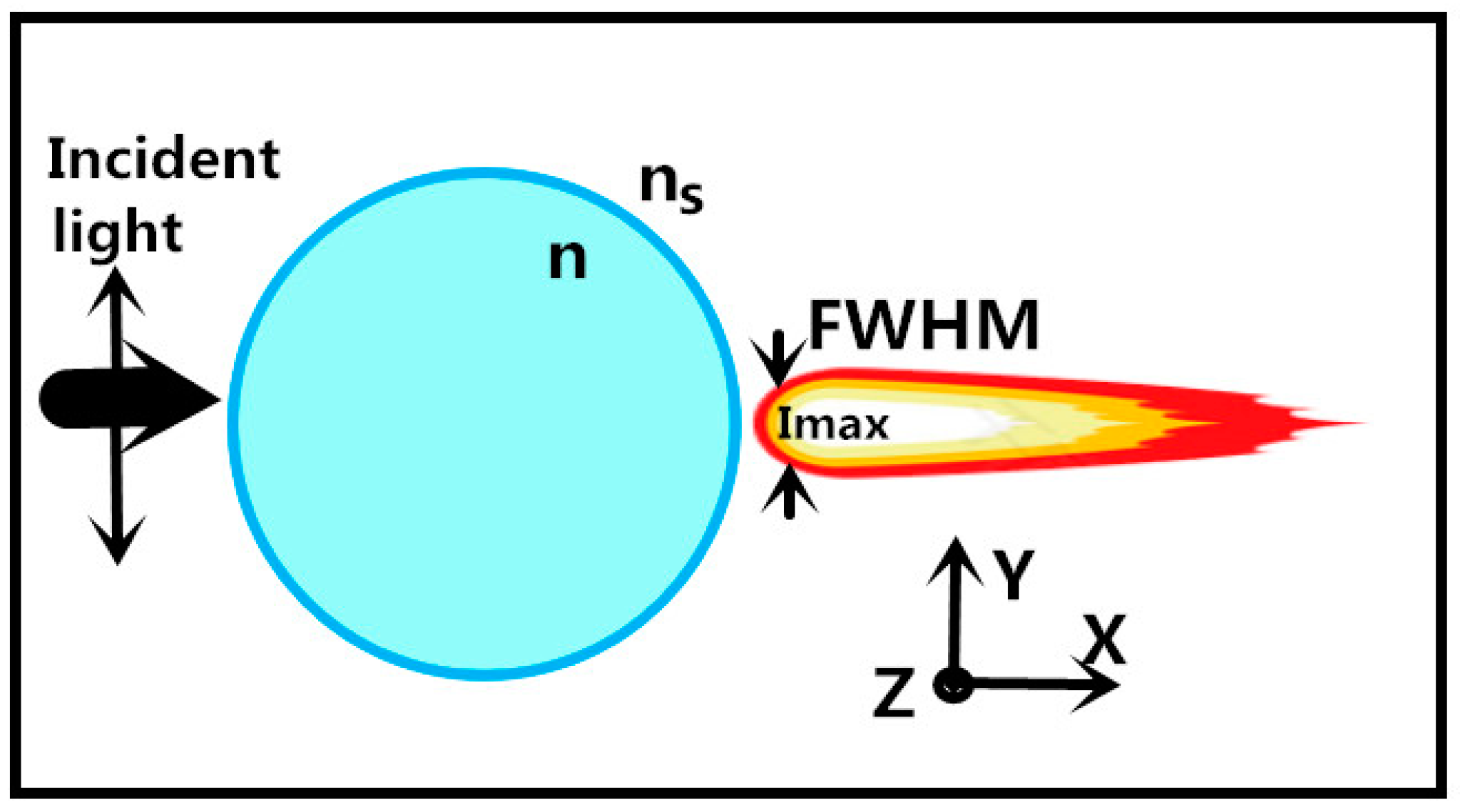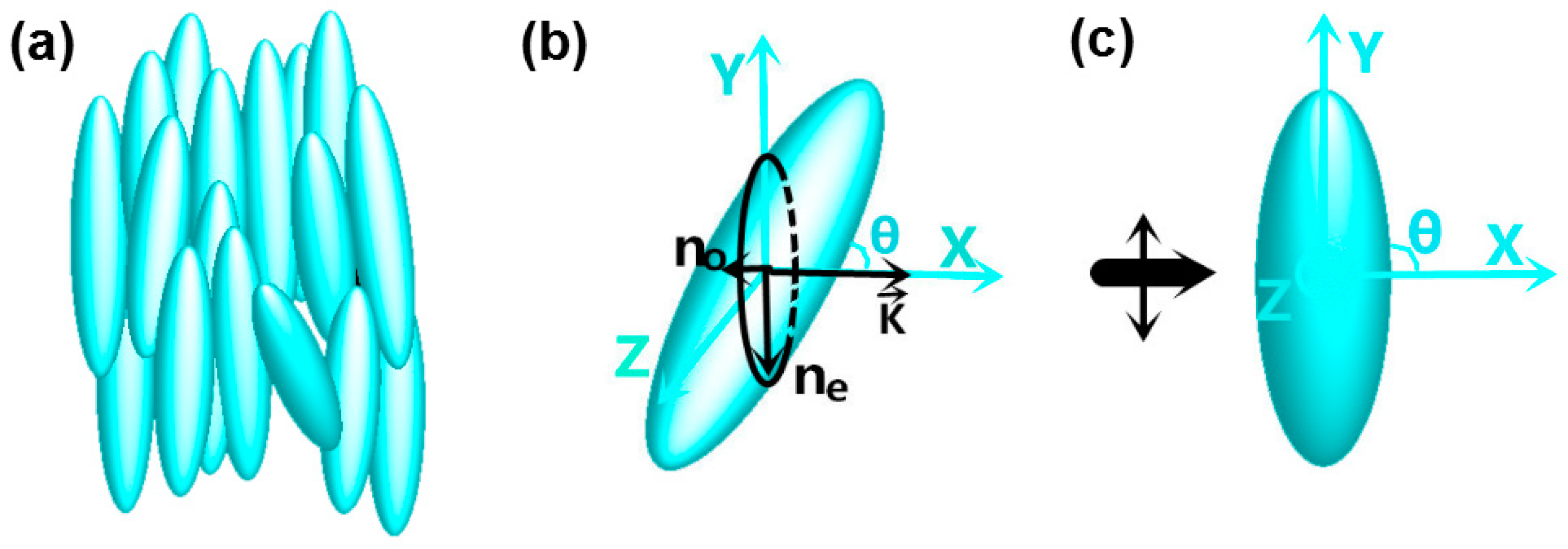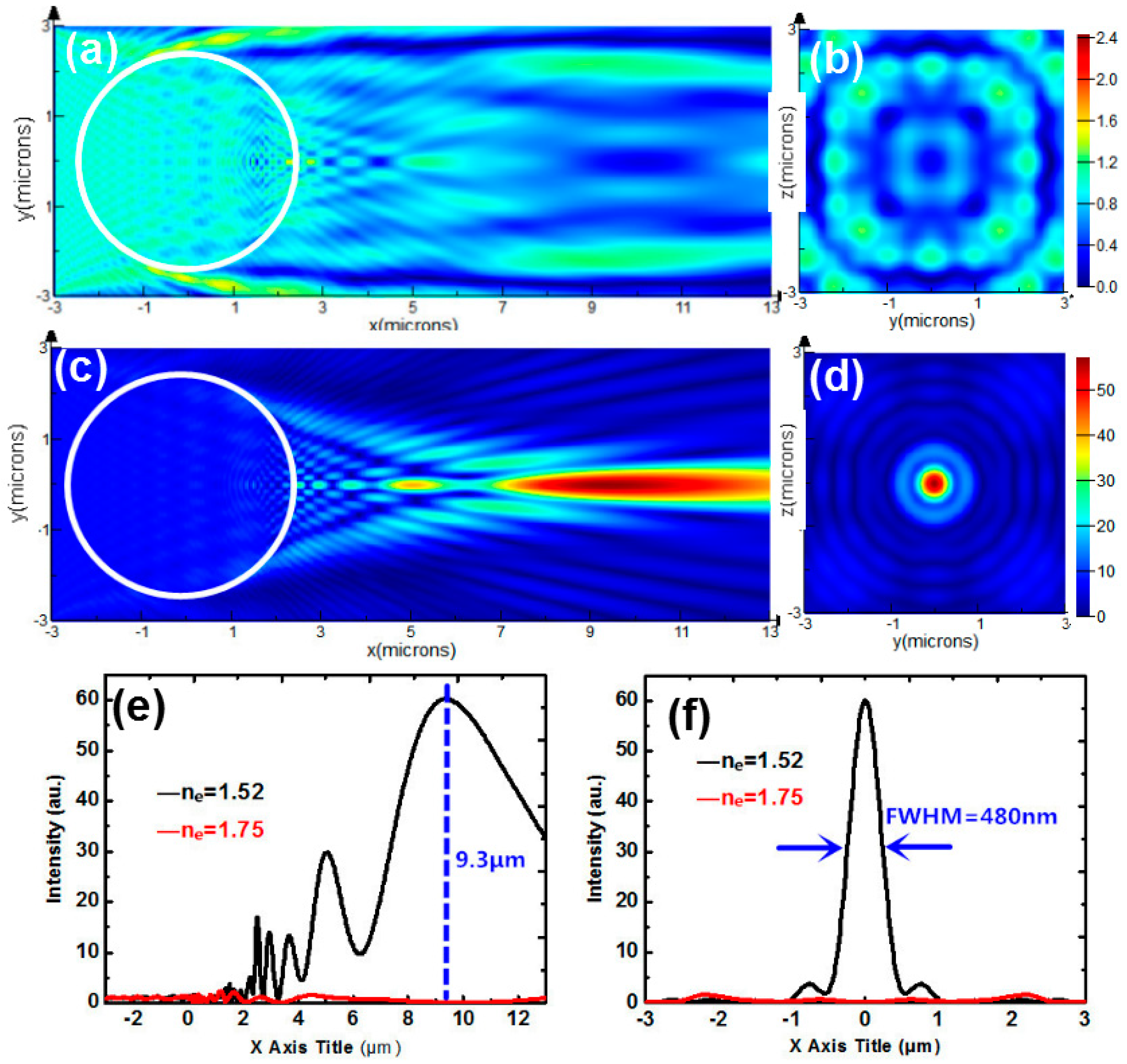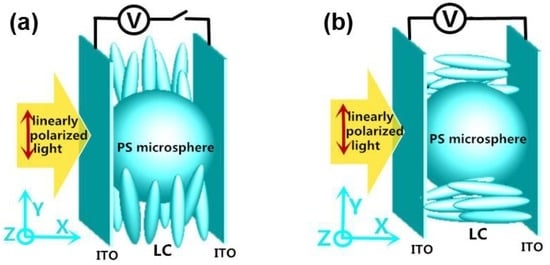Switchable Photonic Nanojet by Electro-Switching Nematic Liquid Crystals
Abstract
:1. Introduction
2. Influence of Surrounding Medium on PNJ
3. Birefringence of Nematic Liquid Crystals (LNCs)
4. Materials and Methods
5. Results and Discussion
6. Conclusions
Author Contributions
Funding
Conflicts of Interest
References
- Mansdield, S.M.; Kino, G.S. Solid immersion on microscope. Appl. Phys. Lett. 1990, 57, 2615–2616. [Google Scholar] [CrossRef]
- Wu, W.; Katsnelson, A.; Memis, O.G.; Mohseni, H. A deep sub-wavelength process for the formation of highly uniform arrays of nanoholes and nanopillars. Nanotechnology 2007, 18, 485302. [Google Scholar] [CrossRef] [Green Version]
- Li, X.; Chen, Z.; Taflove, A.; Backman, V. Optical analysis of nanoparticles via enhanced backscattering facilitated by 3-D photonic nanojets. Opt. Express. 2005, 13, 526–533. [Google Scholar] [CrossRef] [PubMed]
- Kong, S.; Sahakian, A.V.; Heifetz, A.; Taflove, A.; Backman, A. Robust detection of deeply subwavelength pits in simulated optical data-storage disks using photonic jets. Appl. Phys. Lett. 2008, 92, 211102. [Google Scholar] [CrossRef]
- Scale, T.R.M. Smallest focal spot. Phys. Rev. Lett. 1998, 81, 3844–3847. [Google Scholar] [CrossRef]
- Sheppard, C.J.R. Fundamentals of superresolution. Micron 2007, 38, 165–169. [Google Scholar] [CrossRef] [PubMed]
- Betzig, E.; Trautman, J.K. Near-field optics: Microscopy, spectroscopy, and surface modification beyond the diffraction limit. Science 1992, 257, 189–195. [Google Scholar] [CrossRef]
- Dunn, B. Near-field scanning optical microscopy. Chem. Rev. 1999, 99, 2891–2928. [Google Scholar] [CrossRef]
- Chen, Z.; Taflove, A.; Backman, V. Photonic nanojet enhancement of backscattering of light by nanoparticles: A potential novel visible-light ultramicroscopy technique. Opt. Express 2004, 12, 1214–1220. [Google Scholar] [CrossRef]
- Itagi, A.V.; Challener, W.A. Optics of photonic nanojets. J. Opt. Soc. Am. A 2005, 22, 2847–2858. [Google Scholar] [CrossRef]
- Lecler, S.; Takakura, Y.; Meyrueis, P. Properties of a three-dimensional photonic jet. Opt. Lett. 2005, 30, 2641–2643. [Google Scholar] [CrossRef] [PubMed]
- Gu, G.; Zhou, R.; Chen, Z.; Xu, H.; Cai, G.; Cai, Z.; Hong, M. Super-long photonic nanojet generated from liquid-filed hollow microcylinder. Opt. Lett. 2015, 40, 625–628. [Google Scholar] [CrossRef] [PubMed]
- Yang, S.; Wang, X.; Wang, J.; Cao, Y.; Wang, F.; Chen, T.; Ye, Y. Reduced distortion in high-index microsphere imaging by partial immersion. Appl. Optics. 2018, 57, 7812–7822. [Google Scholar] [CrossRef] [PubMed]
- Chen, Z.G.; Li, X.; Taflove, A.; Backman, V. Superenhanced backscattering of light by nanoparticles. Opt. Lett. 2006, 31, 196–198. [Google Scholar] [CrossRef] [PubMed]
- Gerlach, M.; Rakovich, Y.P.; Donegan, J.F. Nanojets and directional emission in symmetric photonic molecule. Opt. Express 2007, 15, 17343–17350. [Google Scholar] [CrossRef] [PubMed]
- Kapitonov, A.M.; Astratov, V.N. Observation of nanojet-induced modes with small propagation losses in chains of coupled spherical cavities. Opt. Lett. 2007, 32, 409–411. [Google Scholar] [CrossRef] [PubMed]
- Yang, H.; Trouillon, R.; Huszka, G.; Gijs, M.A.M. Super-resolution imaging of a dielectric microsphere is Governed by the waist of its photonic nanojet. Nano Lett. 2016, 16, 4826–4870. [Google Scholar] [CrossRef]
- Lecler, S.; Haacke, S.; Lecong, N.; Crégut, O.; Rehspringer, J.-L.; Hirlimann, C. Photonic jet driven nonlinear optics: Example of two-photon fluorescence enhancement by dielectric microspheres. Opt. Express 2007, 15, 4935–4942. [Google Scholar] [CrossRef]
- Heifetz, A.; Simpson, J.J.; Kong, S.-C.; Taflove, A.; Backman, V. Subdiffraction optical resolution of a gold nanosphere located within the nanojet of a Mie-resonant dielectric microsphere. Opt. Express 2007, 15, 17334–17342. [Google Scholar] [CrossRef]
- Yang, S.; Wang, F.; Ye, Y.; Xia, Y.; Deng, Y.; Wang, J.; Cao, Y. Influence of the photonic nanojet of microspheres on microsphere imaging. Opt. Lett. 2017, 25, 27551–27558. [Google Scholar] [CrossRef]
- Ferrand, P.; Wenger, J.; Devilez, A.; Pianta, M.; Stout, B.; Bonod, N.; Popov, E.; Rigneault, H. Direct imaging of photonic nanojets. Opt. Express 2008, 16, 6930–6940. [Google Scholar] [CrossRef] [PubMed]
- Mcleod, E.; Arnold, C.B. Subwavelength direct-write nanopatterning using optically trapped microspheres. Nat. Nanotechnol. 2008, 3, 413–417. [Google Scholar] [CrossRef] [PubMed]
- Wang, Z.; Guo, W.; Li, L.; Luk’Yanchuk, B.; Khan, A.; Liu, Z.; Chen, Z.; Hong, M. Optical virtual imaging at 50 nm lateral resolution with a white-light nanoscope. Nat. Commun. 2011, 2, 218. [Google Scholar] [CrossRef] [PubMed] [Green Version]
- Heifetz, A.; Huang, K.; Sahakian, A.V.; Li, X.; Taflove, A.; Backman, V. Experimental confirmation of backscattering enhancement induced by a photonic jet. Appl. Phys. Lett. 2006, 89, 221118. [Google Scholar] [CrossRef]
- Kong, S.-C.; Sahakian, A.V.; Taflove, A.; Backman, V. Photonic nanojet-enabled optical data storage. Opt. Express 2008, 18, 13713–13719. [Google Scholar] [CrossRef]
- Devilez, A.; Stout, B.; Bonod, N. Compact metallo-dielectric optical antenna for ultra directional and enhanced radiative emission. ACS Nano 2010, 4, 3390–3396. [Google Scholar] [CrossRef] [PubMed]
- Darafsheh, A. Influence of the background medium on imaging performance of microsphere-assisted super-resolution microscopy. Opt. Lett. 2017, 42, 735–738. [Google Scholar] [CrossRef]
- Matsui, T.; Okajima, A. Finite-difference time-domain analysis of photonic nanojets from liquid-crystal-containing microcylinder. Jpn. J. Appl. Phys. 2013, 53, 01AE04. [Google Scholar] [CrossRef]
- Matsui, T.; Tsukuda, K. Direct imaging of tunable photonic nanojets from a self-assembled liquid crystal microdroplet. Opt. Lett. 2017, 42, 4663–4666. [Google Scholar] [CrossRef]
- Eti, N.; Giden, H.; Hayran, Z.; Rezaei, B.; Kurt, H. Manipulation of photonic nanojet using liquid crystals for elliptical and circular core-shell variations. J. Mod. Opt. 2017, 64, 1566–1577. [Google Scholar] [CrossRef]
- Liu, C.-Y. Tunable photonic nanojet achieved using a core-shell microcylinder with nematic liquid crystal. J. Mod. Opt. 2013, 60, 538–543. [Google Scholar] [CrossRef]
- Liu, C.-Y. Tunable nanojet-induced mode achieved by coupled core-shell microcylinders with nematic liquid crystals. Phys. Lett. A 2014, 378, 229–234. [Google Scholar] [CrossRef]
- Wang, H.-T.; Lin, J.-D.; Lee, C.-R.; Lee, W. Ultralow-threshold single-mode lasing based on a one-dimensional asymmetric photonic bandgap structure with liquid crystal as a defect layer. Opt. Lett. 2014, 39, 3516–3519. [Google Scholar] [CrossRef] [PubMed]
- Khoo, I.-C. Liquid Crystal Optics and Electro-Optics. In Liquid Crystals, 2nd ed.; John Wiley & Sons: Inc.: Hoboken, NJ, USA, 2007; Chapter 6; pp. 124–153. ISBN 978-970-471-75153-3. [Google Scholar]
- Poulin, P.; Weitz, D. Inverted and multiple nematic emulsions. Phys. Rev. E 1998, 57, 626–637. [Google Scholar] [CrossRef]
- Ramaswamy, S.; Nityananda, R.; Raghunathan, V.; Prost, J. Power-Law Forces Between Particles in a Nematic. Mol. Cryst. Liq. Cryst. 1996, 288, 175–180. [Google Scholar] [CrossRef]
- Luk’Yanchuk, B.; Paniagua-Dominguez, R.; Minin, I.; Minin, O.; Wang, Z. Refractive index less than two: Photonic nanojets yesterday, today and tomorrow. Opt. Mater. Express 2017, 7, 1820–1847. [Google Scholar] [CrossRef]
- Geints, Y.; Zemlyanow, A.; Panina, E. Photonic nanojet calculations in layered radially inhomogeneous micrometer-sized spherical particles. J. Opt. Soc. Am. B 2011, 28, 1825–1830. [Google Scholar] [CrossRef]
- Kovrov, A.; Novitsky, A.; Karabchevsky, A.; Shalin, A. A Photonic Nanojet as Tunable and Polarization-Sensitive Optical Tweezers. Ann. Phys. 2018, 530, 1800129. [Google Scholar] [CrossRef]








© 2019 by the authors. Licensee MDPI, Basel, Switzerland. This article is an open access article distributed under the terms and conditions of the Creative Commons Attribution (CC BY) license (http://creativecommons.org/licenses/by/4.0/).
Share and Cite
Du, B.; Xia, J.; Wu, J.; Zhao, J.; Zhang, H. Switchable Photonic Nanojet by Electro-Switching Nematic Liquid Crystals. Nanomaterials 2019, 9, 72. https://doi.org/10.3390/nano9010072
Du B, Xia J, Wu J, Zhao J, Zhang H. Switchable Photonic Nanojet by Electro-Switching Nematic Liquid Crystals. Nanomaterials. 2019; 9(1):72. https://doi.org/10.3390/nano9010072
Chicago/Turabian StyleDu, Bintao, Jun Xia, Jun Wu, Jian Zhao, and Hao Zhang. 2019. "Switchable Photonic Nanojet by Electro-Switching Nematic Liquid Crystals" Nanomaterials 9, no. 1: 72. https://doi.org/10.3390/nano9010072




